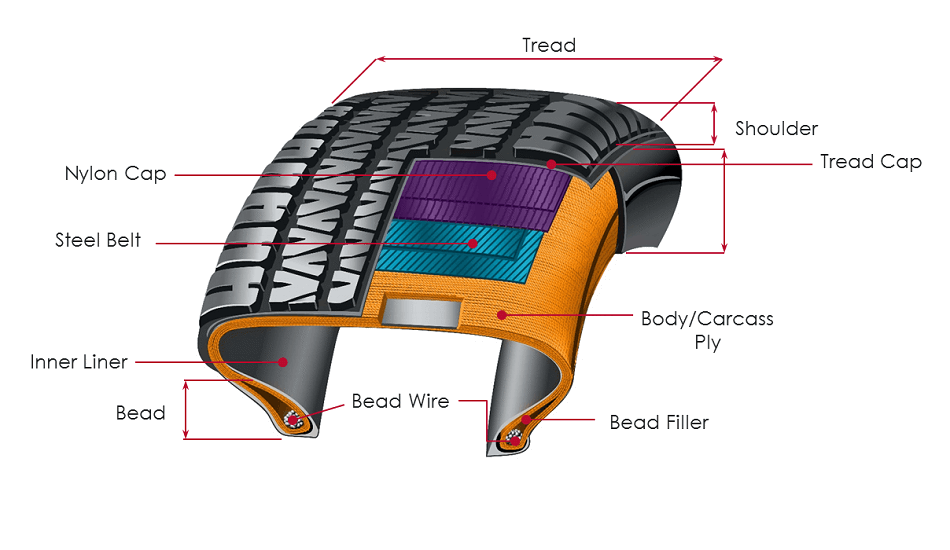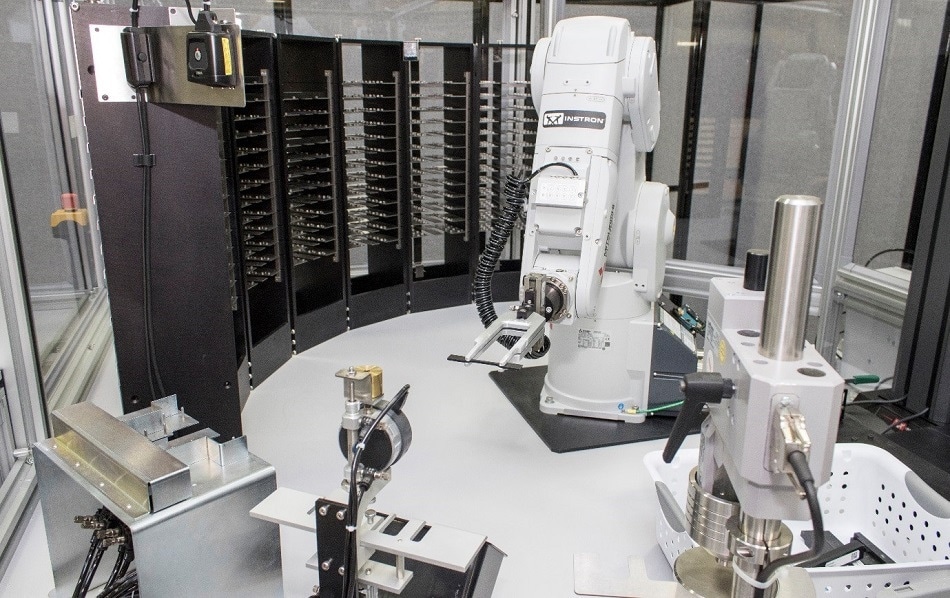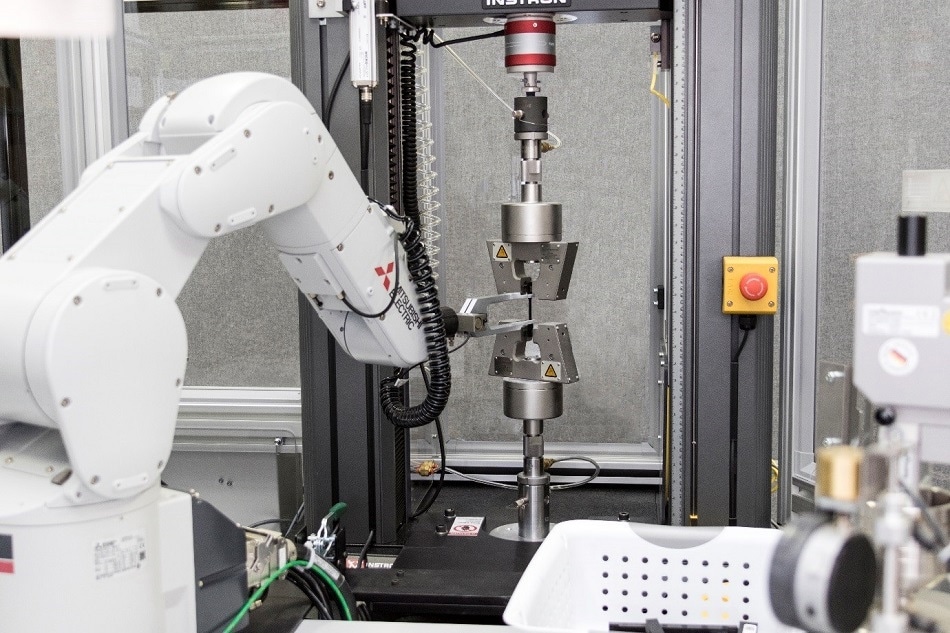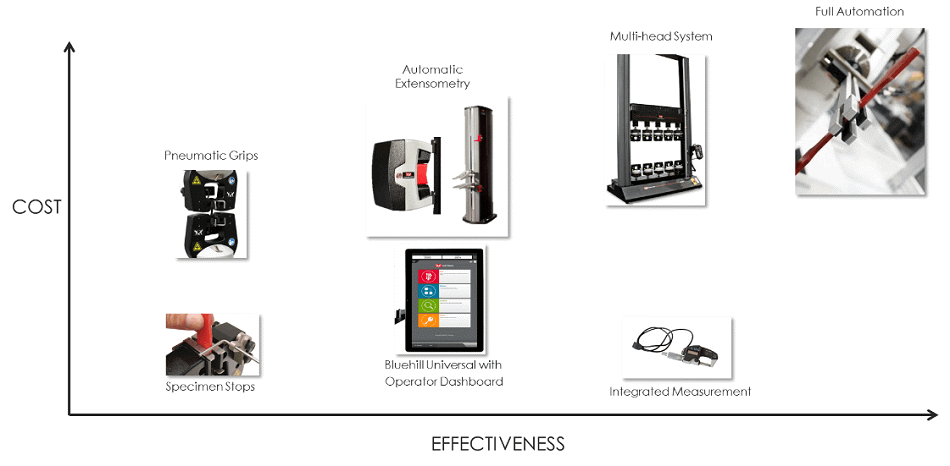
In this interview AZoM speaks to Matt Mahier from Instron about tire testing, the applications and solutions.
How many materials typically go in to making a tire?
Tires can seem simple on the surface, but there’s much more than rubber keeping today’s vehicles moving forward. In some cases, there can be upwards of 200 raw materials that make up a finished tire. This includes various types of natural and synthetic rubbers, chemical additives, and reinforcement materials such as metal or textile cables.

What testing methods are used to test the physical properties of each material?
Typically, the first thing that comes to mind when thinking about tire testing is a wear test, but in reality, there are a number of other tests involved in the manufacturing process. Raw materials are tested to determine material properties, including tensile, rheology, and tear tests. After the raw material stage, adhesion tests are able to confirm that each of the many layers in the tire are properly bonded to one another. Impact tests are performed to simulate real-life scenarios involving poor road conditions, or debris contacting the tire at speed. Finally, fatigue and wear tests ensure that the tires have the long-term durability and reliability that consumers demand.
Is this done before or after production?
Testing is performed throughout the entire production cycle, from raw materials to the finished product. It really depends on the type of lab that’s conducting the testing. For example, in a production facility, the lion’s share of testing will be quality control tests, which are conducted periodically throughout the process to ensure quality requirements are met and that a consistent product is produced. However, the largest volume of testing is typically done in the research and development labs. This runs counter to what you’ll find in most other industries that use Instron equipment. The high testing volume is in part due to these research centers developing so many new compounds of materials. This requires that these labs have a high-throughput, which is why many are equipped with Instron’s most efficient automation machines.


What are the main considerations when performing tension tests on rubber?
One of the most dynamic factors concerning tire testing is the extreme variation of climates in which the tires are used. Consumers can (and do) drive from warm, sandy beach climates with salt in the air, straight up into the mountains where tires are subjected to sub-freezing temperatures and unpaved roads. This means that today’s tires must be designed to deal with anything that Mother Nature can throw at them, while still providing a comfortable ride. Tensile testing tire materials requires that the rubber, most importantly, be tested in these temperature ranges. Environmental chambers are used to mimic these conditions, which requires solutions for specimen gripping and strain measurement within the chamber. Measuring strain can be particularly challenging, especially with high-elongation rubber that can stretch to over 1000% of its original length.
Another consideration is the metal reinforcing cables within tires. They are typically extremely strong, and gripping these metal cables for a tension test can be particularly difficult. Most reinforcement materials, whether textile or metal, will be spun with other strands to increase the strength. This means that there may not be adequate gripping of each strand, or there may be too high of a clamping force in a localized area, causing premature failure. Specialized cable grips must be used, which have the advantage of a very high clamping force paired with a sloping profile along which the gripping stress is evenly distributed.
What are the industry standards and how do they apply to different specimen types?
A considerable part of the testing performed by manufacturers is testing that has been developed in-house, and not pertaining to particular standards. However, there are many different standards that the industry uses, which can be segmented by the different types of tests:
| Tensile Test |
| ATSM D412 |
Standard Test Methods for Vulcanized Rubber and Thermoplastic Elastomers - Tension |
| ISO 37 |
Rubber, vulcanized or thermoplastic - Determination of tensile stress-strain properties |
| DIN 53504 |
Testing of rubber - Determination of tensile strength at break, tensile stress at yield, elongation at break, and stress values in a tensile test |
| ASTM D2970/D2970M |
Standard Test Methods for Testing Tire Cords, Tire Cord Fabrics, and Industrial Yarns Made From Glass Filaments |
| ASTM D2969 |
Standard Test Methods for Steel Tire Cords |
| ISO 12493 |
Rubber, vulcanized -- Determination of stress in tension upon heating |
| ISO 13934-1 |
Textiles - Tensile properties of fabrics - Part 1: Determination of maximum force and elongation at maximum force using the strip method |
| ASTM D885 |
Standard Test Methods for Tire Cords, Tire Cord Fabrics, and Industrial Filament Yarns Made from Manufactured Organic-Base Fibers |
| ASTM D4975-14 |
Standard Test Methods for Single-Filament Tire Bead Wire Made from Steel |
| ASTM D7269/D7269M-11 |
Standard Test Methods for Tensile Testing of Aramid Yarns |
| Tear Test |
| ASTM D624 |
Standard Test Method for Tear Strength of Conventional Vulcanized Rubber and Thermoplastic Elastomers |
| Adhesion Test |
| ASTM D1871-04 |
Standard Test Method for Adhesion Between Tire Bead Wire and Rubber |
| ASTM D2229-10 |
Standard Test Method for Adhesion Between Steel Tire Cords and Rubber |
| ASTM D4776/D4776M-10 |
Standard Test Method for Adhesion of Tire Cords and Other Reinforcing Cords to Rubber Compounds by H-Test Procedure |
| Compression Test |
| ISO 7743 |
Rubber, vulcanized or thermoplastic - Determination of compression stress-strain properties |
| ASTM D575 |
Standard Test Methods for Rubber Properties in Compression |
| Fatigue Test |
| ASTM D6588/D6588M-11 |
Standard Test Method for Fatigue of Tire Cords (Disc Fatigue Test) |
| SAE J2562 |
Biaxial Wheel Fatigue Test |
What testing solutions does Instron offer that meet these requirements?
Instron has a wide variety of testing systems and solutions, including automation systems for high-volume testing. Instron’s Advanced Video Extensometer 2 (AVE 2) is an optical non-contacting strain solution that works well for elastomers, both at ambient temperature and while testing inside an environmental chamber. Pneumatic side-action grips are an ideal solution for both ambient and non-ambient testing, providing a high-throughput, versatile gripping solution. Instron has a catalog containing thousands of testing accessories that can be used to meet various industry standards, along with the testing requirements for many other applications.
What are the current issues surrounding tire testing?
In research and development environments, the sheer volume of testing required on a daily basis can often be incredible. Labs must have an operation that is efficient, yet free from errors, while maintaining a continuously high throughput. Accurate test data is absolutely critical in the tire testing world, as the cost of failure in the field can be disastrous. Thus, the combination of high-throughput and high-accuracy of testing creates a sizeable challenge for tire development labs.
Application-wise, the challenges we hear most often from our customers typically relate to strain measurement or gripping. For example, a customer might have trouble with a grip that experiences slippage on difficult to grip materials, or they might need a way to measure strain on high elongation materials.
Another issue in the tire testing realm is the sheer number of tire-related tests that are required from raw material to finished product. Staying on top of the latest test standards and revisions can be daunting, especially because there are so many tests that may be required, as shown in the table earlier.
What does Instron offer to overcome these challenges?
We encourage our customers to send us specimens that can be tested in our applications lab so we can recommend optimal gripping and strain solutions. Automation systems are an excellent solution for quality control situations, as they greatly increase test throughput and reduce the variability that naturally occurs from using different operators and systems. However, a full automation system isn’t the only option, as Instron also offers a number of products within our spectrum of automation products, including high-throughput pneumatic gripping solutions, automated specimen measurement, non-contacting optical extensometry, and barcode data input.
As noted earlier, accurate test data is absolutely critical in tire testing, and the use of automated or semi-automated systems greatly reduces the inherent risks associated with a fully manual testing system.

How have tire materials changed in recent years?
As with many industries around the world, the tire industry is now working with lighter, stronger, and more robust materials that have introduced new and more difficult testing challenges than in the past. One of the major impacts this has had on the materials testing industry is that these new materials require stronger grips that can provide the right amount of clamping pressure without inducing the localized stresses that can cause premature failure and invalidate a test.
How has Instron adapted to these changes and what do you plan to do in the future?
Instron works closely with standards organizations as well as those in the tire industry to adapt to ever-changing test requirements and material properties. A number of our grips and fixtures have been created or improved based on industry trends, ensuring Instron customers can test ahead of the curve with a richer understanding of their material’s properties.
Where can our readers learn more about Instron tire testing solutions?
Instron has a comprehensive automotive testing website that incorporates information on tire testing and other automotive solutions. From here, users can explore industry and materials solutions, keep up with new blog posts, and browse all that Instron has to offer. There’s also a comprehensive tire testing applications presentation that is uploaded to SlideShare.
As always, contact Instron if you wish to learn more.
About Matt Mahier
Matt Mahier is an Applications Engineer with Instron, focused on the automotive industry. Matt started at Instron as a field service engineer, which allowed him to learn the product and the customers from a unique perspective prior to working as an Applications Engineer at company’s HQ. Matt has undergraduate degrees in Audio Engineering Technology and Electrical Engineering Technology, and will be completing an Interdisciplinary Engineering Master’s degree with a concentration in industrial engineering from Purdue University in May of 2018.

Disclaimer: The views expressed here are those of the interviewee and do not necessarily represent the views of AZoM.com Limited (T/A) AZoNetwork, the owner and operator of this website. This disclaimer forms part of the Terms and Conditions of use of this website.